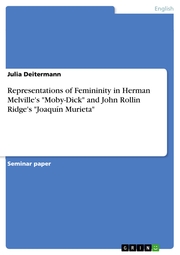Detailansicht
Representations of Femininity in Herman Melville's 'Moby-Dick' and John Rollin Ridge's 'Joaquín Murieta'
eBook
ISBN/EAN: 9783638546225
Umbreit-Nr.: 6804551
Sprache:
Englisch
Umfang: 12 S., 0.47 MB
Format in cm:
Einband:
Keine Angabe
Erschienen am 18.09.2006
Auflage: 1/2006
E-Book
Format: PDF
DRM: Nicht vorhanden
- Zusatztext
- Seminar paper from the year 2004 in the subject American Studies - Literature, grade: 1,0, San Diego State University, course: The American Renaissance, language: English, abstract: In the 19th century, when both Moby-Dick and Joaquín Murieta were written, a separation of gender roles was common. Whereas men were responsible for work and money, women usually accounted for the domestic sphere and did not have much of a voice. At first glance, both Moby-Dick and Joaquín Murieta seem to support this view as women play a rather passive if not invisible role in the novels. However, an examination of the role of femininity shows that it is indeed a major part of both stories. In Joaquín Murieta, Ridge regards the love of a woman as support and refuge for men. Women show such a strong affection towards their men that they would never leave them alone and vice versa, men appreciate the loyal love of their woman which they can also count on in miserable times. Ridge also uses femininity to describe both Murietas appearance and his gentle character, for he is loved by women and treats them with respect. Melville, on the other hand, does not allow women an active role in the story. He puts emphasis on the ideal relationship between men on a whaling ship where they depend on each other and are in some way wedded. Women, on the contrary, are left behind by the sailors and represent the domestic sphere which mostly exists in the sailors memories and forms a sharp contrast to the adventures at sea. Whereas Ridge generally allows women a more active role in his story and at times presents them as almost equivalent companions of men, Melville ascribes a domestic role to the dependent widows and substitutes women for men, whales, and nature - all of them turning into symbols of femininity. In his novel Moby-Dick, Melville creates a generally male world. A striking fact is the frequent use of the words he, appearing almost 2000 times, and man or men, being used over 800 times. Words connected to woman or wife, however, only appear about 35 times in the book. On the whole, Melville does not allow women an active role, but commonly refers to them as sailors wives or widows (p. 43) being left behind by their men when they go on a long journey across the sea that might be their last. Melville repeatedly underlines womens abandonment and dependence; for example, when he asserts that the Pequod is held by Captain Bildad and Captain Peleg but also by a crowd of old annuitants; widows, fatherless children, and chancery wards; each owning about the value of a timber head, or a foot of plank, or a nail or two in the ship (p. 73). [...]
- Kurztext
- Seminar paper from the year 2004 in the subject American Studies - Literature, grade: 1,0, San Diego State University, course: The American Renaissance, 2 entries in the bibliography, language: English, abstract: In the 19th century, when both Moby-Dick and Joaquín Murieta were written, a separation of gender roles was common. Whereas men were ...
